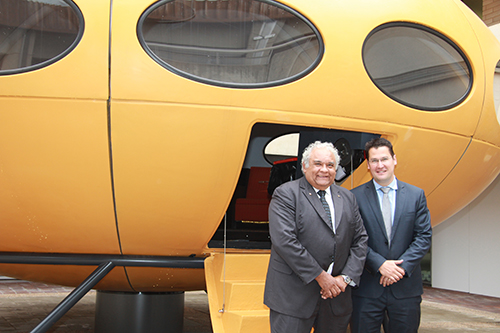New home to UC's 'flying saucer' opens
Claudia Doman and Chris Davis
14 October 2014: After extensive renovations, the University of Canberra's Building 5, home to our famous 'Futuro' flying saucer, has been officially opened by ACT Senator Zed Seselja and University of Canberra Chancellor Tom Calma AO.

|
UC Chancellor Tom Calma AO and ACT Senator Zed Seselja explore the University's Futuro 'flying saucer' building. Photo: Claudia Doman |
The $9.9 million building refurbishment features state-of-the-art teaching spaces, an acoustic recording room, and additional shade cover and furniture for the building's courtyard.
The building will now serve as the new headquarters for the University of Canberra College (UCC).
Dr Calma said the makeover also includes a complete restoration of the funky, Finnish-designed Futuro as a meeting room, which is located in the building's courtyard.
"It's great to say we're the only university in Australia to have its own flying saucer," Dr Calma said.
"Along with this unique building, the new headquarters will feature the latest technologies in providing supportive, flexible and connected learning to meet students' needs."
The University's Building 5 features a new open-plan space and a variety of rooms using the latest in computer technology that will allow people to record meetings, Skype and work on collaborative projects.
Futuro has been fully upgraded and re-painted in its original orange colour to allow students and teachers to use the space as an interactive meeting space.
The UFO inspired structure was a feature of the old Canberra Planetarium, before it was donated to the University of Canberra by the Tradies Club in 2011.
The prefabricated plastic and fibreglass Futuro buildings were the brainchild of Finnish architect Matti Suuronen in 1968. They could be transported by helicopter in one piece or dismantled into 16 pieces.
Around 100 of them were built before the oil crisis of the 1970s pushed up the price of materials. Only two in the world have been restored – one in Helsinki and one in Rotterdam.


